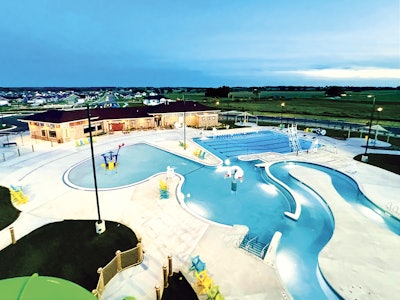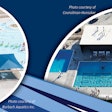
Cracked paint, chipped tiles, leaks and “What is that sound coming from the mechanical room?” are all signs of an impending pool renovation.
For some aquatics facility owners, the concept of a renovation may spark dreams of the “wow factor,” while others may sigh at the “necessary evil” of large-scale pool renovations.
But pool renovation does not have to be intimidating. The most common reasons for large-scale projects at the pool include leaking, repainting or mechanical upgrades, and these are projects that industry pros tackle every day. Several facility owners and pool renovation industry professionals spoke with AB to highlight the pool renovation process in three major stages: approval and budgeting, demolition and construction and the grand opening.

Budgeting and RFP
Lowell Pool in Boise, Idaho, was built in 1953, but it has been left unused since 2020. The unique above-ground facility has an Art Deco design style, complete with bright colors, glass blocks and decorative lettering. In 2024, Boise’s City Council voted on the future of Lowell Pool — as well as its fellow vintage facility, South Pool — with two potential outcomes: renovate or rebuild.
“Due to the size constraints at the Lowell location, constructing a new pool on site was not an option,” says Doug Holloway, director of Parks and Recreation in Boise.
The City Council ultimately voted to renovate Lowell Pool, but to start from scratch on South Pool. “Understanding the complexity of the renovation and the cost associated with that, the renovation may cost significantly more than building a brand-new pool,” Holloway says. “In our plan, we anticipate Lowell to cost at least $1 million to $2 million more than building a new pool to replace South Pool. However, we won’t know the exact cost until the actual renovation starts, since we have no idea what the contractor will encounter.”
The citizens of Boise were adamant about the historic value of Lowell Pool, which has been a community staple for generations. Holloway says the choice to renovate tested the value of history for both elected leadership and the community. Now that the votes are in, he says the next step is to begin the RFP process and find a qualified design team. Holloway and the city hope to have the search completed by the end of summer.
It is a process that many parks and recreation professionals are well acquainted with, as was Jason Sergeant, city administrator and finance director in Evansville, Wis. For the Evansville Aquatic Center, which opened to the public in June 2024, Sergeant recalls, “We had a large list of folks who applied to the RFP.” The massive scope of Evansville’s project yielded a final price tag of $15 million.
Holloway says he will be keeping his eyes — and his mind — wide open when it comes to the price and the process. Before the physical labor of the renovation can begin, Holloway’s team must sift through applications from potential building and design partners. Hollow says he is hoping to “find a construction manager or general contractor relationship that has a historic pool renovation background, that would be a huge win.”

Hard hats
After budgets are approved and architecture, design and construction teams are contracted, the physical work of renovation begins.
“The key is really building the right team early. Start the job with that,” says Anthony Noberto, of Noberto Construction in Commack, N.Y. “Get a good aquatics contractor on board or hire a consultant. Come up with a good, clear design. Then comes the execution of the demo, site prep and reconstruction. Every step along the way needs to be adhered to before you can fill water in the pool, balance it and turn it over to the client.”
Once the design is finalized and the team has their marching orders, the work begins from the top down. For Noberto, a second-generation pool builder who often works in the New York area, “The most frequent type of renovation is a replastering job on an existing pool. Blasting the whole interior shell, taking off the plaster and then redoing the tile lanes and markings in the pool. That’s very common. So is regrouting. We do a simple regrout of the entire structure. Mechanical system upgrades and changes. Introducing ultraviolet units to the older pool is always a good one.”
It is a robust process for pool owners. Mike Comstock, vice president of sales for RenoSys, says that, in his experience, there are typically a few main reasons for renovating a pool. “They’re either painting the pool every two or three years,” he says. “Or they’re losing water. So, the goal is to make the structure itself watertight.”
RenoSys specializes in installing PVC pool shells and stainless-steel gutters, and the team has brought these innovations to pools of all levels, including high schools, colleges, municipalities, YMCAs and private health clubs. Comstock emphasizes that relationships and quality craftsmanship have been key to RenoSys’ growth. “Once you have a good experience with somebody,” he says, “you’re going to keep going to them.”
At RenoSys’ recent Astoria Park project in Queens, N.Y., a PVC pool shell was installed along with an updated gutter system. That project totaled $19 million, and upon completion in June 2024, New York City mayor Eric Adams lauded it as the city’s “French Riviera.”
Despite the wide range of projects in RenoSys’ portfolio, Comstock says, “The renovation is the renovation. Their issues just might be a little different.”
Comstock knows that the specifics of every renovation will depend on the customer’s needs and budget, but one thing remains the same. “We’re typically the last ones in there,” Comstock adds, “because we give a finishing product. You don’t want somebody to put a slide up and drop something on this brand-new liner.”
The timeline for being the last ones in there can vary according to Comstock. He recalls some decisive clients signing contracts and receiving products in a matter of weeks. But a project with a larger scope and wider network of stakeholders could take over a year to complete.
No matter how long the renovation process, Comstock says, “Seeing a project from the quote stage, to when the crews take the final picture and they’re proud of how the project turned out. That’s cool to see the process.”
Meanwhile, Noberto, who has worked on a variety of project scopes, says that understanding the nuances in commercial pools is a top priority, especially when it comes to codes and regulations.
“In older facilities that we are bringing up to code with a renovation, what will happen is — if it is a major renovation, such as a retiling job or a mechanical system renovation — those piping systems do not match current codes today,” Noberto explains, adding that hiring an aquatics designer right off the bat is key, as some design teams “don’t take into consideration what the current standards are, or they don’t match the current codes. So, we have to change everything again.”
At one of Noberto’s most memorable projects, he says he and his team removed the top two feet of a clover-shaped pool. “We actually cut it, and we installed a radius stainless-steel gutter on this pool,” he says. “Having the fabrication of the stainless steel done to match the existing pool, we had special precautions. In cutting that top of the pool off, we actually had to use diamond chains.”
Ensuring the new stainless-steel gutters fit required outside expertise. “To get the radius correct, I hired a subcontractor to laser map the entire pool,” Noberto says. “A few million data points were drawn to map that pool.”
Noberto describes being nervous about the final fit and finish of that project, but it fit perfectly. “It came out really beautiful,” says Noberto. “It was definitely a challenge to cut the top and put it back, watertight.”
While not every pool is as challenging as that clover-shaped behemoth, Noberto notes other challenges in pool renovations can include working within the existing building structures and completing a seamless demolition.
“Sequencing of things really has to be adhered to throughout the project,” says Noberto. “It’s easier said than done.”
There are unique challenges and considerations for aquatics facilities regardless of which stage of the renovation the facility is in. Contractors like Comstock and Noberto will continue renovating pools across the country, sealing leaks and updating gutters to bring a high-quality aquatic experience to all.

Ribbon-cutting
In Wisconsin, the new Evansville Aquatic Center replaces the town’s previous pool at Leonard-Leota Park. Evansville Parks and Recreation welcomed community members to the new aquatic center in June 2024.
“It was very well received,” says Sergeant. “Our first year open, we had a line out the door immediately. We were running at capacity almost every day last summer, to the point that we were kind of considering closing admission early some days.”
The aquatic center has quickly become a centerpiece in the community, and it offers a robust selection of amenities compared to the previous, aging facility. Features include a zero-depth entry pool; a six-lane, 25-yard lap pool; a lazy river; a waterslide and a climbing wall.
“The original pool was built in the late 1950s. It was just a simple lap pool with a deep end and a shallow end,” Sergeant says. “We had a study done in 2017 to take a look at what needed to be updated, and the conclusion from that study was that the tub was okay, but it needed a new deck, new equipment, and a new building and bathhouse.”
While the new Evansville Aquatic Center represents a freshly built facility, the previous pool has been renovated and is open once again as a splash pad for all ages. In converting the original pool footprint into a splash pad, Sergeant says that community members with young children have an accessible facility, and the park gets an updated look. The new splash pad serves as an example of a unique solution for communities looking to repurpose outdated aquatics facilities.
In parting with their architect and design teams, MSA and Water Technology Inc, Sergeant recalls their advice, ‘Are you ready? You’re going to have a line out there.’ And we were like, ‘No, that’s not going to happen.’ It definitely happened. Oh my goodness.”
The $15 million project, encompassing both the new facility and the renovated splash pad, is what Sergeant and his team started referring to as a “generational project.”
“Our old pool lasted for 60 years, and thinking forward to 50 years from now, what does our community look like?” Sergeant asks. “The biggest advice I would give [to other communities] is to think forward. Don’t look backward on what your facilities have been, but look forward to where you would like them to go. Do all you can to get there.”





































